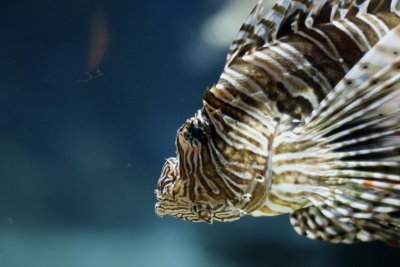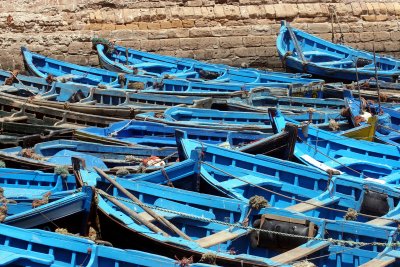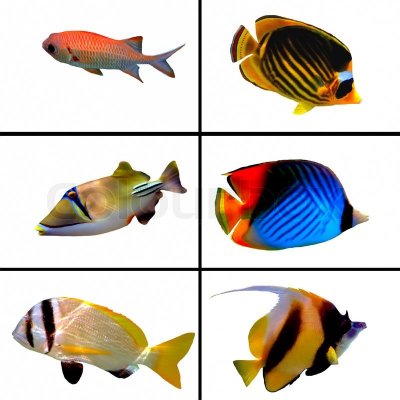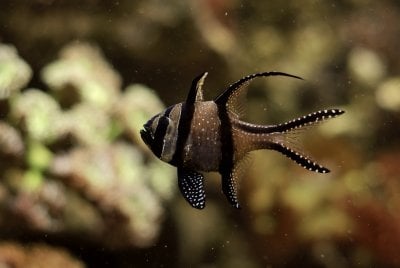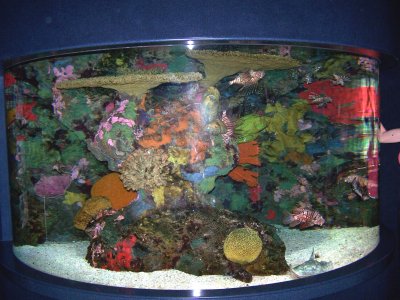All images unless otherwise noted sourced from morguefile.com: free photos by creatives, for creatives. All other images are public domain photos.
Many aquarists know the name Snorkel Bob. He once served as Sea Shepherd Conservation Societies’ (SSCS) vice president. He owns a network of snorkel and dive shops that operate all around the Hawaiian Islands and he has published several books about Hawaiian marine life and native fish. Also, Snorkel Bob is a steadfast arch-enemy of the aquarium trade and hobby. For years now, Snorkel Bob (real name Robert Witner) has been working to abolish aquarium livestock collection throughout Hawaii and eventually around the world. Allied with Sea Shepherd and the Humane Society of America, Snorkel Bob wants to see an end to marine fish and corals in captivity. Just when many of us thought he had disappeared from the public eye, suddenly he pops back up, now fundraising for a documentary film entitled The Dark Hobby (this was also the title of a series of essays Witner wrote for SSCS’ website, detailing his belief that the livestock trade was responsible for removing entire fish populations from Hawaii’s reefs).
Boutique documentary films are popular these days, often regardless as to whether or not the information they contain is entirely accurate. We only need to look at the success of Blackfish to understand the effect a documentary can have on public opinion. Blackfish totally ignored discussion about Seaworld’s contributions to our understanding of marine mammals, or their wild-conservation. The film cherry-picked a few scenarios and focused on only those, bringing disgruntled former staff out of the wood-work to bash the marine park. The recipe worked, as Blackfish was able to not only decrease Seaworld’s attendance revenue, but also promote legislation that outlawed their captive Orca breeding program in several states.
Will The Dark Hobby have a similar effect, resulting in a sudden public distrust and hatred of the marine aquarium hobby? Could it potentially lead to stricter laws and decreased species availability? If the industry and hobby was blemish free, it’s likely that any documentary film that paints a negative portrayal of the hobby and industry could quickly be de-bunked. Sadly, there are issues that The Dark Hobby is likely to bring to light, issues that permeate the marine aquarium trade and hobby.
Is wild livestock collection good or bad?
The vast majority of freshwater aquarium fish are captive bred. In fact, getting our hands on a wild-collected freshwater fish is far more difficult than buying a captive raised specimen. While animal rights issues still exist within the freshwater aquarium world, often it doesn’t get much attention from conservation groups. Most marine aquarists are aware that the vast majority of marine livestock comes from the ocean. Difficulties (and costs) associated with captive breeding have prevented large-scale marine fish aquaculture. This simple and unavoidable fact means that the hobby has a measurable impact on wild-ecosystems. Combine this with wild collection of live rock, coral along with other marine aquarium necessities and an annual 4-billion-dollar industry exists based on taking animals out of the wild. The effect climate change had had on diminishing reefs worldwide has brought a spotlight of attention onto oceanic ecosystems. Years ago there wasn’t concern about the hobbies’ effect on wild reefs, but since then the industry supporting aquariums has grown and the ocean has come under a litany of threats.
Many (if not the majority) of the fish offered for sale to marine aquarists come from two locales, the Philippines and Indonesia. The island chain of Indonesia represents one of the largest countries on Earth and is home to the coral triangle, an area of great marine bio-diversity. Both the Philippines and Indonesia are considered under-regulated or un-regulated fisheries. This means that there is little enforcement of existing fishery laws and data about the fisheries’ impact is sparse at best. Cyanide collection is illegal in both Indonesia and the Philippines, but a lack of enforcement means that most cyanide fishers don’t get caught and without a cyanide test (to determine if a species was exposed to cyanide during collection) it’s impossible to determine how many fish are collected with poison. Cyanide collection devastates reef ecosystems by killing both fish and corals. Over the past few years it’s been thought that cyanide fishing has become less ubiquitous throughout livestock collection, however some sources report that it’s still as common as ever. Most cyanide collected fish are so fatally damaged by the poison that they die shortly after entering the aquarium supply chain.
Australia has a better environmental track record than the Philippines or Indonesia but Australian collected fish often command a much higher price than those collected from Indonesia or the Philippines, meaning that fish collected in under-regulated waters are often purchased in lieu of those collected from Hawaii or Australia. Hawaii is considered by some to be a model of livestock collection, due to the presence of no-take reefs, where collection is not permitted at all. The Waikiki Aquarium praised the effect no-take reefs have had on fish populations targeted by marine fish collectors.
Survivability:
Not long ago, National Geographic reported that 90% of marine fish offered for sale to aquarists were collected with cyanide. Since the livestock fishery is data deficient, it’s hard to gauge if that statistic is true. However, we do know that the survival rate among wild collected fish is poor. It’s likely that for each living fish within our aquariums, 10 died to provide that one living specimen. A host of issues contribute to that; conditions shortly after collection (where fish are left in crude containers, in the hot sun with no filtration), conditions at exporters (where large numbers of fish are crammed into small quarters), excessively long transportation times (while fish are flown around the world to marine fish importers) and the stress of changing hands (and thus environments) numerous times before finding an aquarist’s tank. Add to this recipe of decreased survival the presence of cyanide collected fish and you have a serious cause of concern for agencies like NOAA and the U.S. Marine Fisheries Service, which monitor and enforce commerce’s effect on the environment.
The U.S. Lacey Act:

US Capitol public domain imageThe U.S. Lacey Act states that any animal illegally collected in its source country, is illegal for import or sale in the United States. Since cyanide collection is illegal in both the Philippines and Indonesia, in reality cyanide collected fish are illegal to sell here in the U.S. Recently, the Lacey Act has been used as a legislative spring-board for conservation groups aiming to regulate or shut-down the marine livestock trade. This hasn’t gained traction simply because there isn’t a way to test for cyanide in live fish. In order to test for cyanide’s presence, a fish needs to be killed or already dead, meaning that without dead livestock there is no way for enforcers to quickly prove something was collected with cyanide.
An over-zealous conservation effort:

Twitter cover of Wild Earth Guardians/public domain photoSeveral conservation groups have turned to the Endangered Species Act (ESA) to gain full legal protection for individual marine species popular in the aquarium trade. A conservation group petitioned NOAA to add clownfish to the ESA list several years ago, but research funded by PIJAC (Pet Industry Joint Advisory Council, a lobbying group) showed that advances in clownfish breeding meant it was unlikely the trade was impacting wild populations. Wild Earth Guardians was successful in having the Bangaii Cardinalfish added to the ESA, however captive breeding of this species has prevented any regulation on the species from being imposed, at least for now.
The reality is, a concerted effort exists within the conservation world to end the collection, sale and keeping of wild-collected marine fish and it seems as though with each new year, groups are dedicating their resources to protecting popular aquarium species. When groups are unsuccessful in showing that the aquarium trade is severely impacting species worldwide, they often turn to climate change and other stressors to show populations are at threat of becoming extinct.
Not all is bad:
If properly regulated, monitored and reported marine livestock collection could be a force to promote conservation. Many marine fish are collected from locales where poor islanders are left with little to no opportunity. This has led islanders to devastate their local reefs with dynamite fishing (for the Chinese live-food fish market) and limestone harvest (for the industrial construction market). Neither market encourages the preservation of reef habitats and encourages destructive practices that destroy reef ecosystems.
The livestock trade offers an economically viable alternative that also promotes good stewardship of local reefs. Since a healthy marine fish is worth more than a dead (or even live) food fish and corals can fetch a pretty penny abroad, properly implemented livestock collection could force local islanders to take care of the reefs surrounding them. The issue lies with enforcement, as source countries are often poor and ill-equipped to monitor and enforce livestock collection laws.
Even better, a balanced mixture of both wild collected and aqua-cultured livestock would reduce the burden on wild populations and still offer islanders a reason to preserve and maintain local reefs.
Focus on Hawaii:

Public domain map of HawaiiIt’s important to understand that according to the United Nations, the ocean is the common heritage of man. This means in Hawaii (and anywhere else really), no one group can stake claim over the ocean and its resources. This means that fish collectors cannot shut-out other groups (divers, sport fishermen, etc) and other groups (conservationists, dive shop owners) cannot shut out aquarium fish collectors. The state of Hawaii has jurisdiction to regulate the in-shore fishery (within 3 miles of the coast-line). Outside of three miles, the fishery falls under federal enforcement jurisdiction, which states that ocean resources must be regulated, monitored and conserved. U.S. federal environmental laws are based off United Nations rulings.
The law encourages industries that utilize the ocean (and its resources) to work together for the common good and this includes conservation. The Hawaiian livestock collection industry respects these laws by not taking fish from closed tourism areas and also respecting areas closed for ecosystem preservation. The collectors of Hawaii claim that for years they have maintained stationary catches (meaning the amount of fish collected hasn’t changed) and a stationary number of collectors (meaning the number of collectors hasn’t changed). Hawaii’s collection industry also employs some of the latest life support technologies and efficient shipping procedures to ensure the health of wild-collected fish. Hawaii is known to have the strictest laws of any locale which allows live wild fish collection.
Hawaii’s wild fish collection industry feels it has done a good job of sustaining local fish populations, respecting other industries and caring for Hawaii’s reefs. They challenge people like Snorkel Bob claiming that he (and his supporters) seek to re-define how the ocean is used and relates to mankind.
Snorkel Bob and his followers point too endemic (found only in one locale) Hawaiian fish, which they claim have been nearly eradicated due to aquarium collection. An example often thrown around is the popular dwarf Potter’s Angelfish. Many anti-aquarium proponents claim this species has nearly disappeared from Hawaiian reefs, which constitute the entirety of its natural range.
Impact of the film:
It’s without a doubt that The Dark Hobby could be a disaster for public perception of the marine aquarium trade/hobby and one that leads to increased pressure on legislators to enact wider reaching legislation. Much of this will revolve around how the film is accepted by audiences and whether or not it’s adopted by a major distributor. Without a doubt, it was when CNN films purchased the rights to Blackfish that the film started becoming a household name and generated a large degree of hype.
Will celebrities, the public and even lawmakers be picketing for tighter restrictions or an end to marine aquariums once The Dark Hobby is released? It’s hard to say, but given Snorkel Bob’s past exploits I am not overly concerned as of yet. However, I think it would be wise of the industry to “get its house in order” in the event the film snowballs to mainstream success.
Snorkel Bob has ridden the anti-aquarium wave for quite some time, blaming the aquarium industry for much of what ails Hawaiian reefs, whether or not the evidence supported those conclusions. He has backed and aided in writing numerous bills to shut-down or severely limit Hawaii’s live fish collection protocol. As of yet, none have been overly successful and many of Witner’s theories have been debunked by marine biologists and researchers. I’m not surprised he’s decided to switch formats and pursue a documentary film. Boutique environmental documentaries are popular these days and especially useful at shifting the opinion of uninformed masses of people.
Many aquarists know the name Snorkel Bob. He once served as Sea Shepherd Conservation Societies’ (SSCS) vice president. He owns a network of snorkel and dive shops that operate all around the Hawaiian Islands and he has published several books about Hawaiian marine life and native fish. Also, Snorkel Bob is a steadfast arch-enemy of the aquarium trade and hobby. For years now, Snorkel Bob (real name Robert Witner) has been working to abolish aquarium livestock collection throughout Hawaii and eventually around the world. Allied with Sea Shepherd and the Humane Society of America, Snorkel Bob wants to see an end to marine fish and corals in captivity. Just when many of us thought he had disappeared from the public eye, suddenly he pops back up, now fundraising for a documentary film entitled The Dark Hobby (this was also the title of a series of essays Witner wrote for SSCS’ website, detailing his belief that the livestock trade was responsible for removing entire fish populations from Hawaii’s reefs).
Boutique documentary films are popular these days, often regardless as to whether or not the information they contain is entirely accurate. We only need to look at the success of Blackfish to understand the effect a documentary can have on public opinion. Blackfish totally ignored discussion about Seaworld’s contributions to our understanding of marine mammals, or their wild-conservation. The film cherry-picked a few scenarios and focused on only those, bringing disgruntled former staff out of the wood-work to bash the marine park. The recipe worked, as Blackfish was able to not only decrease Seaworld’s attendance revenue, but also promote legislation that outlawed their captive Orca breeding program in several states.
Will The Dark Hobby have a similar effect, resulting in a sudden public distrust and hatred of the marine aquarium hobby? Could it potentially lead to stricter laws and decreased species availability? If the industry and hobby was blemish free, it’s likely that any documentary film that paints a negative portrayal of the hobby and industry could quickly be de-bunked. Sadly, there are issues that The Dark Hobby is likely to bring to light, issues that permeate the marine aquarium trade and hobby.
Is wild livestock collection good or bad?
The vast majority of freshwater aquarium fish are captive bred. In fact, getting our hands on a wild-collected freshwater fish is far more difficult than buying a captive raised specimen. While animal rights issues still exist within the freshwater aquarium world, often it doesn’t get much attention from conservation groups. Most marine aquarists are aware that the vast majority of marine livestock comes from the ocean. Difficulties (and costs) associated with captive breeding have prevented large-scale marine fish aquaculture. This simple and unavoidable fact means that the hobby has a measurable impact on wild-ecosystems. Combine this with wild collection of live rock, coral along with other marine aquarium necessities and an annual 4-billion-dollar industry exists based on taking animals out of the wild. The effect climate change had had on diminishing reefs worldwide has brought a spotlight of attention onto oceanic ecosystems. Years ago there wasn’t concern about the hobbies’ effect on wild reefs, but since then the industry supporting aquariums has grown and the ocean has come under a litany of threats.
Many (if not the majority) of the fish offered for sale to marine aquarists come from two locales, the Philippines and Indonesia. The island chain of Indonesia represents one of the largest countries on Earth and is home to the coral triangle, an area of great marine bio-diversity. Both the Philippines and Indonesia are considered under-regulated or un-regulated fisheries. This means that there is little enforcement of existing fishery laws and data about the fisheries’ impact is sparse at best. Cyanide collection is illegal in both Indonesia and the Philippines, but a lack of enforcement means that most cyanide fishers don’t get caught and without a cyanide test (to determine if a species was exposed to cyanide during collection) it’s impossible to determine how many fish are collected with poison. Cyanide collection devastates reef ecosystems by killing both fish and corals. Over the past few years it’s been thought that cyanide fishing has become less ubiquitous throughout livestock collection, however some sources report that it’s still as common as ever. Most cyanide collected fish are so fatally damaged by the poison that they die shortly after entering the aquarium supply chain.
Australia has a better environmental track record than the Philippines or Indonesia but Australian collected fish often command a much higher price than those collected from Indonesia or the Philippines, meaning that fish collected in under-regulated waters are often purchased in lieu of those collected from Hawaii or Australia. Hawaii is considered by some to be a model of livestock collection, due to the presence of no-take reefs, where collection is not permitted at all. The Waikiki Aquarium praised the effect no-take reefs have had on fish populations targeted by marine fish collectors.
Survivability:
Not long ago, National Geographic reported that 90% of marine fish offered for sale to aquarists were collected with cyanide. Since the livestock fishery is data deficient, it’s hard to gauge if that statistic is true. However, we do know that the survival rate among wild collected fish is poor. It’s likely that for each living fish within our aquariums, 10 died to provide that one living specimen. A host of issues contribute to that; conditions shortly after collection (where fish are left in crude containers, in the hot sun with no filtration), conditions at exporters (where large numbers of fish are crammed into small quarters), excessively long transportation times (while fish are flown around the world to marine fish importers) and the stress of changing hands (and thus environments) numerous times before finding an aquarist’s tank. Add to this recipe of decreased survival the presence of cyanide collected fish and you have a serious cause of concern for agencies like NOAA and the U.S. Marine Fisheries Service, which monitor and enforce commerce’s effect on the environment.
The U.S. Lacey Act:

US Capitol public domain image
An over-zealous conservation effort:

Twitter cover of Wild Earth Guardians/public domain photo
The reality is, a concerted effort exists within the conservation world to end the collection, sale and keeping of wild-collected marine fish and it seems as though with each new year, groups are dedicating their resources to protecting popular aquarium species. When groups are unsuccessful in showing that the aquarium trade is severely impacting species worldwide, they often turn to climate change and other stressors to show populations are at threat of becoming extinct.
Not all is bad:
If properly regulated, monitored and reported marine livestock collection could be a force to promote conservation. Many marine fish are collected from locales where poor islanders are left with little to no opportunity. This has led islanders to devastate their local reefs with dynamite fishing (for the Chinese live-food fish market) and limestone harvest (for the industrial construction market). Neither market encourages the preservation of reef habitats and encourages destructive practices that destroy reef ecosystems.
The livestock trade offers an economically viable alternative that also promotes good stewardship of local reefs. Since a healthy marine fish is worth more than a dead (or even live) food fish and corals can fetch a pretty penny abroad, properly implemented livestock collection could force local islanders to take care of the reefs surrounding them. The issue lies with enforcement, as source countries are often poor and ill-equipped to monitor and enforce livestock collection laws.
Even better, a balanced mixture of both wild collected and aqua-cultured livestock would reduce the burden on wild populations and still offer islanders a reason to preserve and maintain local reefs.
Focus on Hawaii:

Public domain map of Hawaii
The law encourages industries that utilize the ocean (and its resources) to work together for the common good and this includes conservation. The Hawaiian livestock collection industry respects these laws by not taking fish from closed tourism areas and also respecting areas closed for ecosystem preservation. The collectors of Hawaii claim that for years they have maintained stationary catches (meaning the amount of fish collected hasn’t changed) and a stationary number of collectors (meaning the number of collectors hasn’t changed). Hawaii’s collection industry also employs some of the latest life support technologies and efficient shipping procedures to ensure the health of wild-collected fish. Hawaii is known to have the strictest laws of any locale which allows live wild fish collection.
Hawaii’s wild fish collection industry feels it has done a good job of sustaining local fish populations, respecting other industries and caring for Hawaii’s reefs. They challenge people like Snorkel Bob claiming that he (and his supporters) seek to re-define how the ocean is used and relates to mankind.
Snorkel Bob and his followers point too endemic (found only in one locale) Hawaiian fish, which they claim have been nearly eradicated due to aquarium collection. An example often thrown around is the popular dwarf Potter’s Angelfish. Many anti-aquarium proponents claim this species has nearly disappeared from Hawaiian reefs, which constitute the entirety of its natural range.
Impact of the film:
It’s without a doubt that The Dark Hobby could be a disaster for public perception of the marine aquarium trade/hobby and one that leads to increased pressure on legislators to enact wider reaching legislation. Much of this will revolve around how the film is accepted by audiences and whether or not it’s adopted by a major distributor. Without a doubt, it was when CNN films purchased the rights to Blackfish that the film started becoming a household name and generated a large degree of hype.
Will celebrities, the public and even lawmakers be picketing for tighter restrictions or an end to marine aquariums once The Dark Hobby is released? It’s hard to say, but given Snorkel Bob’s past exploits I am not overly concerned as of yet. However, I think it would be wise of the industry to “get its house in order” in the event the film snowballs to mainstream success.
Snorkel Bob has ridden the anti-aquarium wave for quite some time, blaming the aquarium industry for much of what ails Hawaiian reefs, whether or not the evidence supported those conclusions. He has backed and aided in writing numerous bills to shut-down or severely limit Hawaii’s live fish collection protocol. As of yet, none have been overly successful and many of Witner’s theories have been debunked by marine biologists and researchers. I’m not surprised he’s decided to switch formats and pursue a documentary film. Boutique environmental documentaries are popular these days and especially useful at shifting the opinion of uninformed masses of people.



